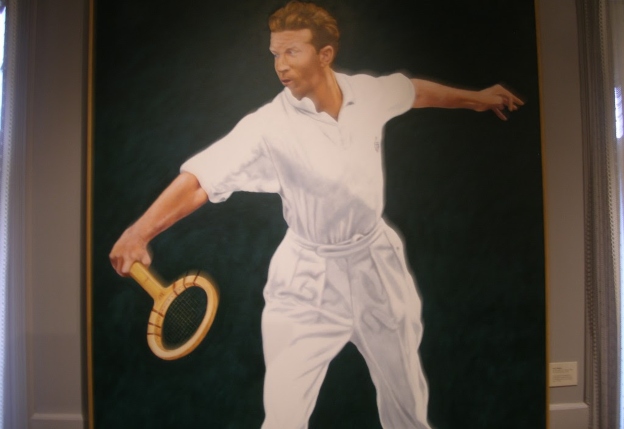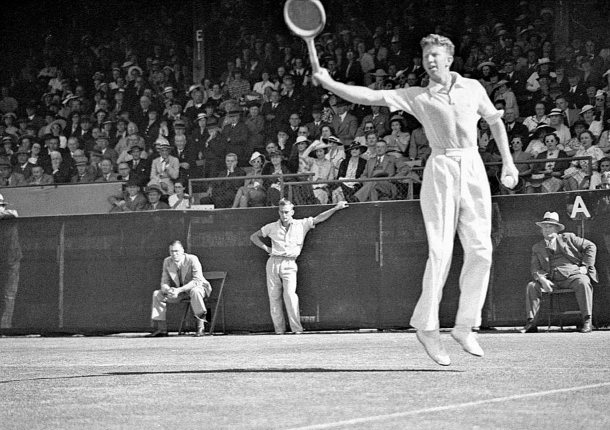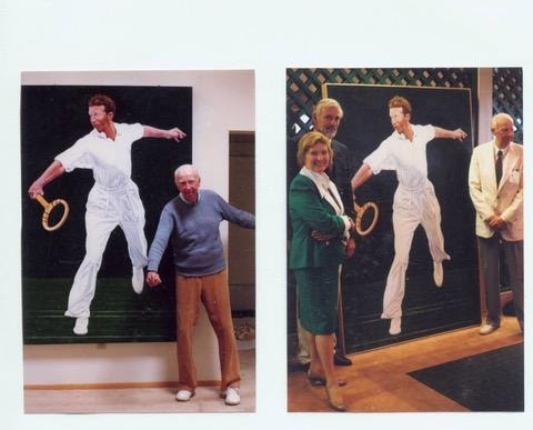
By Scoop Malinowski | @TennisNow | Sunday, January 5, 2025
Photo credit: Scoop Malinowski
Eighty-six years before Jannik Sinner's rise to World No. 1, another powerful red-headed champion completed tennis' impossible dream.
American Don Budge made history as the first champion—man or woman—to complete the calendar Grand Slam in his glorious 1938 season. It was a phenomenal feat from a public parks player from Oakland, California that changed tennis forever. The term "Grand Slam" was created because of Don Budge's major season sweep.
Pegula: Swiatek Case Evokes Faith and Frustration
If you've ever visited the International Tennis Hall of Fame, you may know one of the Newport-based Hall's most precious treasures is the life-sized oil painting of Don Budge hitting his iconic backhand that hangs on the wall.
This is the story of how artist, art instructor and tennis coach James Gwynne created the famed oil painting—and the deep friendship he formed with Budge.
A couple of years ago I discovered an astounding fact which then led to a series of insights into tennis history.
Lunch with a childhood friend Drew Murray at his law office revealed that one of our neighbors back in the 1970s, the father of Jennifer and Jeannette—an art instructor and tennis coach James Gwynne—actually painted the Don Budge painting that hangs in the media room at the International Hall of Fame.
The painting is a masterpiece.

Hall of Famer Don Budge cracks his iconic backhand. Photo credit: Wikimedia Commons
The Budge portrait is so arresting I photographed it one year at Newport while reporting on the Hall of Fame Championships and included it on my Don Budge Biofile post.
But there’s more, through the process of painting Don Budge, James Gwynne became dear friends with the former Grand Slam champion in his twilight years living in Eastern Pennsylvania.
I expressed an interest to connect with Mr. Gwynne for some insights into his unique friendship with J. Donald Budge, which was quickly arranged by an email correspondence.
Though I have no memories of Mr. Gwynne as a kid despite living two houses down Vreeland Road in West Milford, he was one of the first people in my life who was connected to tennis. I remember his daughters, Jennifer and Jeannette both played, but never actually saw them play.
James Gwynne was kind to share his memories of Don Budge with me before he passed away on New Year's Eve at the age of 89.
This is the story, in the artist's own words, of how he came to paint Don Budge's portrait, and the friendship they shared.
Artist James Gwynne's Memories of Hall of Famer Don Budge
James Gwynne: For sure, Don Budge was a gutsy guy. One of my favorites is when someone would come up to him and say, “I’m so and so.” Budge would say, “That’s your problem.” He rubbed some people the wrong way, but I accepted him as he was, a colossal world figure who earned every right to be himself. But first a little background. I started tennis when I finished my PhD at age 30, and became instantly hooked. I had never had much success with sports all my life, but I found it in tennis. I have a bunch of trophies to prove it and was hired unlicensed to be a teaching pro at Panther Valley for a couple years until we moved to West Milford. I parted with my daughters when they were in their twenties and built a house in East Stroudsburg where I have been for 35 years. I met a player from Dingman’s Ferry who had his own tennis court and one day when I arrived, Don Budge was standing on the court. I recognized him immediately and within minutes we were playing doubles. When it was my turn to serve, I deliberately served to his backhand which I knew was famous, and sure enough he hit a winner past me. I think he was around 74 or 75. We became good friends immediately and my longtime friend, Marielaine and I, socialized frequently with him and his wife Loriel at their home In Dingman’s Ferry and traveled with them to Newport and Wimbledon.
James Gwynne: During one of our get-togethers I think I must have asked Don if he had any portraits done and he said he did have one but it burned up in a fire. Without hesitation I said that I would do one. He jumped on it but said it could not be small like the little statue of Fred Perry at Wimbledon. So I said I would do a life-sized portrait. So I began the project in my studio and got some black and white photos from the internet. Like a statue, I wanted just him and no people like spectators, etc. And, I wanted to show him hitting his famous backhand. It took me about a month to do the painting and when I thought I was finished I invited Don and Loriel to come to the house and see it. I hung the painting on my living room wall and covered it with a sheet for the dramatic unveiling and they sat on the couch for the presentation. When I pulled the sheet away they gasped in delight, but Loriel said,“His hair was much redder.” So, back to the studio went the painting and in about a week I showed them the fixed painting. They loved it, but Don said, “It’s too big, let’s give it to the Hall of Fame.” I was delighted by that, and sometime later we drove to Newport with me following them with the painting in a big crate on my truck. They must have called the Hall of Fame because we were greeted by workmen who took the painting right away to the Museum. The next day we presented the painting to the Board of Trustees, including Stan Smith, Bud Collins, Tony Trabert. Don introduced me as his Dingman’s Ferry doubles partner (Ha ha) and I nervously gave a little speech, saying, “maybe I should have painted more colorful pants like Bud Collins would wear (small laughter).” Anyway, the painting was graciously accepted and hung in the museum right away. I should add it helped define my relationship with Don better. From then on he introduced me as the artist who did the portrait, which made me more comfortable because I’m sure people wondered who I was, always with Budge.
James Gwynne: 1998 marked the 60th Anniversary of Budge’s Grand Slam and he was honored at the Wimbledon Championships where he sat in the Royal box during the tournament. He invited me, Marielaine, and Lee Miller to come. We joined them the second week of the tournament, and poor Don had been in the hospital in London the first week due to some kind of illness, so he was pretty weak and required my assistance including a wheelchair to get around. Of course he didn’t pay our expenses, but the perks were fantastic. He got us great seats for the the matches all week through the finals of both men and women. We were chauffeured each morning from our hotel to Wimbledon through the gates and the crowds of people.
We also got to meet celebrities in the venues on the grounds where they served strawberries and cream. I remember meeting Jack Nicholson and Chevy Chase who were big tennis fans. At one point photographers wanted a picture of Don with the statue of Fred Perry, so I helped Don get to the sculpture and the photographers asked me to move away. I said, “But, he might fall,” and they said to have him hang on to the sculpture, which he did, and they got their photos.
We attended the traditional Championship banquet which was very special (Novotna and Sampras won that year and were present). Tracy Austin came to our table and asked me to take her picture with Budge, which I did, and she gave me her address to send it to her.
James Gwynne: I had a thrill of a lifetime on Saturday, April 24, 1999. Adidas and the New York Yankees honored Don Budge by inviting him to the game to pay tribute for his many tennis achievements. Because Don needed help in walking I pushed him in a wheel chair down an elevator and along the corridors of Yankee Stadium. We waited in the dugout before the ceremony sitting next to Joe Torre and catcher Joe Girardi in the dugout.
When the moment before the game arrived I assisted Don onto the field and stood with him as the tribute was made over the loudspeakers by Bob Sheppard, Yankee announcer. Yankee pitcher “El Duque”, Orlando Hernandez, came out of the dugout, representing the Yankees, and presented Don with an autographed baseball and shook Don’s hand and mine. After that we enjoyed the game from a special box.
During my “fifteen minutes of fame” I tried to absorb every detail of this hallowed territory from the grass to the dugout, to the stands with applauding players and fans, thinking all the while of Lou Gehrig’s famous remarks from this very spot that he was the “luckiest man” in the world!
To add to the story, Budge said he was invited another time to Yankee Stadium for a home run contest with stars for other sports, and he said he was the only one to hit a home run!
James Gwynne: Budge wanted to meet up with old friend [Baseball Hall of Famer] Bob Feller who was signing balls at Skylands baseball game (in Newton, NJ in 1996). So we went and enjoyed the game in Feller’s box. Feller ate several hot dogs which he said he always loved (me too) and signed two balls for me and my brother Jack (Super Indian fan). I gave Feller a cartoon (attached) which Feller said he would put in his Iowa Museum. Budge knew everybody and vice versa. Feller also loved cars and Budge especially loved this one. It slid off the snowy road on that fateful day in 2000.
James Gwynne: Don had the every morning ritual of driving to Milford, about 20 miles round trip to his favorite breakfast on the menu: The Don Budge special, bacon and eggs. That snowy morning his Caddie slid off the road and crashed. He was airlifted to a hospital and later, not sure how many days, he died in a facility in Scranton. I visited him in the hospital and he was comatose. Loriel and his sons were there. It was in the news and when he was in the hospital, Bud Collins called me for a report on his condition.
It was sad and preventable, but that was Budge, fearless and stubborn in so many good ways. He was 85.
Loriel asked me to do his eulogy at a memorial service in Milford later. Some USTA staff were present. There was a luncheon afterwards and off the family went with his ashes, which they almost forgot. His burial place on Wikipedia is “Unknown.”
SM: Which players did Don Budge really like, of any eras, and which not so much? I know Jack Kramer always talked very favorably about Don Budge.
James Gwynne: He had criticism for just about every player I brought up including Sampras who he really liked, but said he stuck out his elbow on his forehand!? However, he loved Vines and said he was the best, and he really liked his opponent Baron Gottfried Von Cramm, saying he was such a gentleman and great sportsman. I remember at the 1998 Wimbledon he said his mother could beat Ivanisevic, who lost to Sampras in five sets in the final. I had the rare opportunity of playing singles with my friend on his court in Dingman’s Ferry with Budge watching.
Of course I was nervous but amazed that this was happening. He didn’t offer any advice or criticism for me, but showed my opponent his famous grip for the backhand, which greatly improved his game from then on (dammit). I used that experience often, pretending that Budge was watching, and it helped me focus on good form when I was playing.
SM: Did he coach any players? What happened to all of his trophies which amounted to well over a thousand he told me in his Biofile.
James Gwynne: No, I don’t remember him talking about coaching any specific player, but wherever we went players sought him out to talk and say hello. He was truly a God of the sport. As for trophies, that’s another story. They asked me to come to the house and take down trophies from shelves everywhere. He sold a lot to the Tennis Hall of Fame for $50,000, I remember, much to the chagrin of his sons.
SM: Did he talk about his matches? Why did he believe Ellsworth Vines was the very best?
James Gwynne: He just thought Vines had all the strokes to beat anyone, and he did. He was the “King: before Budge. Budge talked a lot about his matches, especially one where his opponent fainted after a grueling five-setter. He claimed to have beaten Rod Laver in an exhibition match after Laver had won his first Grand Slam. He lamented that in retirement everyone wanted to play and maybe beat him, but he never backed off. He claimed too that when he played they did train hard, especially aboard ships traveling to tennis tournaments around the world – they jogged and lifted weights, etc. and ate steak. He couldn’t eat steak anymore when I knew him.
Plus, he said he never drank until he retired, but he sure made up for that when I knew him. He loved champagne, followed by Vodka tonics, and winding up with Brandy. Needless to say I had trouble keeping up and Loriel would tell me not to let him have more, but I was in the middle and couldn’t stop him. I helped put him to bed a few times!

Hall of Famer Don Budge (left) poses with famed oil painting of himself. Artist James Gwynne (right) stands next to the painting. Photo credit: International Tennis Hall of Fame & James Gwynne Estate
SM: Incredible how one painting and a connection evolved into such a special friendship with so many wonderful experiences.
James Gwynne: Some of my best benefits from knowing Don Budge came from traveling with him and Loriel to events at the Hall of Fame, especially at the annual induction weekends. I got to meet so many famous players such as Jimmy Connors, John McEnroe, Navratilova, and others. They always approached him to pay their respects and he introduced me as the artist who painted his portrait.
I’ll never forget McEnroe on his knees with one of his little kids at Budge’s feet in the hotel and later that night after the banquet, sitting with John’s father and brother in a bar having beer and John, of course, was talking a lot.
I asked his father if he always talked that much and he said, “Yes, he’s never shut up since he was born.”
Another time we were having dinner at the hotel and the great Aussie players, Rafter, Newcombe, and Roche came to our table to say hello. At the induction ceremonies I got to sit with Budge, Bud Collins – who always called me “The Painter”, especially after I bought his big book – and other dignitaries.
I once sat next to Pancho Sequra and asked him why he stopped coaching Jimmy Connors, and he said, “Because the SOB wouldn’t pay me enough!” Another special time was in Boston where the Davis Cup was played one year. Budge had trouble walking so with lots of help they got him and his wheelchair up a lot of stairs to a box to view the tennis. It didn’t take long for him to get annoyed with the constant drum beating close to us, a tradition in Davis Cup play. So, of course, the help arrived to get him back down and into an air conditioned tent where a lot were watching on TV. At night there was a banquet for many of the former Wimbledon Champions, all wearing their purple and green ties. Boy, did I feel out of place, but loved witnessing this special gathering, and even had a few words with some, including Jack Kramer, whose signature Wilson racquet I and everyone else used at that time!
Anyway, maybe you can appreciate the elite and glamorous environment a “nobody like me” was thrust into because of my famous tennis friend; probably the greatest gift an ordinary tennis player could have.
SM: Did Don have any fierce rivals like McEnroe with Lendl and Connors and Pete and Andre, maybe a little grudge with any players?
James Gwynne: I don’t remember Don Budge saying he didn’t like anyone. He once said he never met an Aussie he didn’t like.
Another fun thing he said was once when he was practicing, Fred Astaire showed up to watch and later told Budge he was so graceful…and they ended up dancing together on the tennis court!
SM: Did you see any hint of Don’s competitive fire and spirit even in his 70s and 80s?
James Gwynne: Not really except for his natural spitfire personality. He often said he played a lot of guys in retirement who just wanted to say they took a set off or beat Don Budge.
He was content in knowing he had nothing to prove but enjoyed playing.